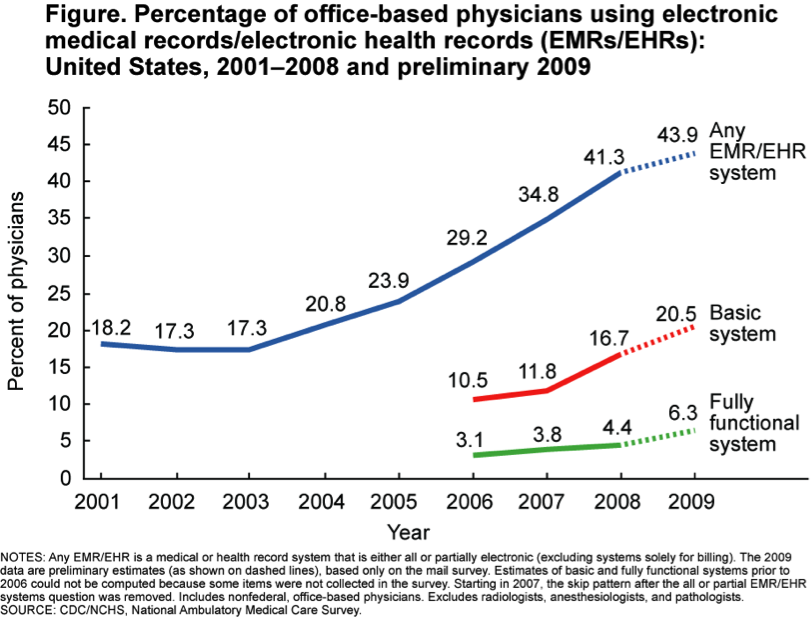Health IT Adoption Rates
Measuring Health IT Adoption
The Office of the National Coordinator for Health IT (ONC) supports two national health IT adoption surveys: one of physician offices and one of hospitals.
The surveys:
- Assess the current state of health IT adoption;
- Specify measurable goals and methods for evaluating strategies; and,
- Determine approaches that can accelerate health IT adoption in a cost-effective manner
| Adoption Rates | ||||
|---|---|---|---|---|
| Setting | 2006 | 2007 | 2008 | 2009 * |
| Physicians offices (basic *) | 11% | 13% | 17% | 21% |
| Physicians offices (full *) | 3% | 4% | 4% | 6% |
| Hospitals (basic *) | N/A | N/A | 8% | N/A |
| Hospitals (full *) | N/A | N/A | 2% | N/A |
*2009 statistics are preliminary.
**"Full" and "Basic" functionalities are outlined below.
Notes: Any EMR/EHR is a medical or health record system that is either all or partially electronic (excluding systems solely for billing). The 2009 data are preliminary estimates (as shown on dashed lines), based only on the mail survey. Estimates of basic and fully functional systems prior to 2006 could not be computed because some items were not collected in the survey. Starting in 2007, the skip pattern after the all or partial EMR/EHR systems question was removed. Includes nonfederal, office-based physicians. Excludes radiologists, anesthesiologists, and pathologists.
Source: CDC/NCHS, National Ambulatory Medical Care Survey.
| Any EHR/EMR System | Basic System | Fully Functional System | |
|---|---|---|---|
| 2001 | 18.2% | ||
| 2002 | 17.3% | ||
| 2003 | 17.3% | ||
| 2004 | 20.8% | ||
| 2005 | 23.9% | ||
| 2006 | 29.2% | 10.5% | 3.1% |
| 2007 | 34.8% | 11.8% | 3.8% |
| 2008 | 41.3% | 16.7% | 4.4% |
| 2009 (Preliminary Data) | 43.9% | 20.5% | 6.3% |
Physician Office Survey:
A national survey was conducted through the CDC National Ambulatory Medical Survey (NAMC) of approximately 2,700 physicians, a response rate of 62%. The survey used a definition for EHRs that was based on expert consensus and determine the proportion of physicians who were using such records in an office setting and the relationship between adoption and the characteristics of individual physicians and their practices.
The survey can be used to define two levels of electronic health record: basic and full.
Hospital Survey:
A national survey of all U.S hospitals was conducted as an appendix to the American Hospital Association (AHA) annual survey. In 2008, the response rate was 63%, representing 3037 hospitals. The survey used a definition for electronic health records that was based on expert consensus and determines the proportion of hospitals who were using such records across the entire hospital as well as the relationship between adoption and certain hospital characteristics.
The survey can be used to define two levels of electronic health record: basic and full.
References:
CDC's Electronic Medical Record/Electronic Health Record Use by Office-based Physicians: United States, 2008 and Preliminary 2009
http://content.nejm.org/cgi/content/abstract/359/1/50 ![]()
http://www.rwjf.org/pr/product.jsp?id=31831 ![]()
Health IT Adoption – Survey Tables
Physician Office Survey:
The survey can be used to define two levels of electronic health record: basic and full, which are defined by the functionalities below.
| Basic | Full | |
|---|---|---|
| Health Information & Data | ||
| Patient demographics | X | X |
| Problem list | X | X |
| Current medications | X | X |
| Clinical notes | X | X |
| Medical hx & follow up | X | |
| Order Entry Management | ||
| Rx orders | X | X |
| Lab orders | X | |
| Radiology orders | X | |
| Rx sent electronically | X | |
| Orders sent electronically | X | |
| Results Management | ||
| View lab results | X | X |
| View imaging results | X | X |
| Images returned | X | |
| Clinical Decision Support | ||
| Drug warnings | X | |
| Out of range levels highlighted | X | |
| Clinical reminders | X | |
| Population Health Management | ||
| Public health reporting | ||
| Notification of diseases | ||
Hospital Survey:
The survey can be used to define two levels of electronic health record: basic and full, which are defined by the functionalities below.
| Basic | Full | |
|---|---|---|
| Electronic Clinical Information | ||
| Patient demographics | X | X |
| Physician notes | X | X |
| Nursing assessments | X | X |
| Problem lists | X | X |
| Medication lists | X | X |
| Discharge summaries | X | X |
| Advance directives | X | |
| Computerized Provider Order Entry | ||
| Lab reports | X | |
| Radiology tests | X | |
| Medications | X | X |
| Consultation requests | X | |
| Nursing orders | X | |
| Results Management | ||
| View lab reports | X | X |
| View radiology reports | X | X |
| View radiology images | X | |
| View diagnostic test results | X | |
| View diagnostic test images | X | |
| View consultant report | X | |
| Decision Support | ||
| Clinical guidelines | X | |
| Clinical reminders | X | |
| Drug allergy results | X | |
| Drug-drug interactions | X | |
| Drug-lab interactions | X | |
| Drug dosing support | X | |
References:
http://content.nejm.org/cgi/content/abstract/359/1/50 ![]()
http://www.rwjf.org/pr/product.jsp?id=31831 ![]()


